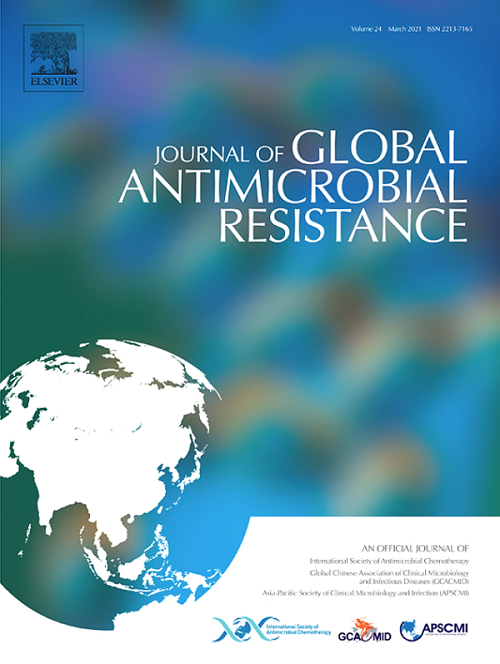Comprehensive analysis of β-lactam resistant non-typhoidal Salmonella Isolates: Phenotypic and genotypic insights from clinical samples in Japan
IF 3.2
3区 医学
Q2 INFECTIOUS DISEASES
引用次数: 0
Abstract
Objective
This study examines β-lactam-resistant non-typhoidal Salmonella isolates using phenotypic and genotypic analyses to elucidate resistance mechanisms and epidemiological characteristics.
Methods
A total of 1663 clinical Salmonella spp. isolates were collected (1994–2016), with 122 exhibiting β-lactam resistance, confirmed via antimicrobial susceptibility testing. Resistance mechanisms were further explored through genotypic analysis by whole genome sequencing, plasmid characterization, and phylogenomic investigations.
Results
All isolates were resistant to at least one β-lactam. Resistance to third-generation cephalosporins was notable, while carbapenem resistance was rare (0.8%). High resistance was observed for minocycline (36.9%) and sulfamethoxazole-trimethoprim (28.7%), whereas resistance to fluoroquinolones (3.3%–5.7%), aminoglycosides (0.8%–8.2%), and tigecycline (8.2%) was low. All isolates remained susceptible to fosfomycin, and 21.3% exhibited multidrug resistance. Genotypic analysis identified diverse serotypes and sequence types, with S. Typhimurium and ST19 being predominant. The most common β-lactamase gene was blaTEM, followed by blaCARB-2, with significant correlations between β-lactam and aminoglycoside resistance genes. Plasmid analysis revealed a high prevalence of plasmid carriage, with IncFII(S) and IncFIB(S) being predominant, strongly associated with antimicrobial resistance genes. Phylogenetic analysis provided insights into the global dissemination of Salmonella, particularly those carrying mcr-9, while clustering analysis revealed shared genetic patterns among isolates sourced from different hosts, highlighting the potential for cross-species transmission.
Conclusions
These findings underscore the complex interplay of resistance mechanisms and emphasize the need for integrated surveillance and intervention strategies to combat antimicrobial resistance in Salmonella, reinforcing the necessity for ongoing public health efforts.
β-内酰胺耐药非伤寒沙门氏菌分离株的综合分析:来自日本临床样本的表型和基因型见解。
目的:本研究利用表型和基因型分析对β-内酰胺耐药的非伤寒沙门氏菌分离株进行研究,以阐明其耐药机制和流行病学特征。方法:收集1994-2016年临床分离的沙门氏菌1663株,其中122株经药敏试验证实对β-内酰胺耐药。通过全基因组测序、质粒鉴定和系统基因组研究,进一步探讨耐药机制。结果:所有菌株均对至少一种β-内酰胺耐药。第三代头孢菌素耐药显著,碳青霉烯类耐药罕见(0.8%)。对米诺环素(36.9%)和磺胺甲恶唑-甲氧苄啶(28.7%)耐药较高,对氟喹诺酮类(3.3% ~ 5.7%)、氨基糖苷类(0.8% ~ 8.2%)和替加环素(8.2%)耐药较低。所有分离株均对磷霉素敏感,其中21.3%表现为多药耐药。基因型分析发现多种血清型和序列型,以鼠伤寒沙门氏菌和ST19为主。β-内酰胺酶基因中最常见的是blaTEM,其次是blaCARB-2, β-内酰胺与氨基糖苷抗性基因之间存在显著相关性。质粒分析显示,携带质粒的比例较高,其中IncFII(S)和IncFIB(S)占主导地位,与耐药基因密切相关。系统发育分析揭示了沙门氏菌的全球传播,特别是携带mcr-9的沙门氏菌,而聚类分析揭示了来自不同宿主的分离株之间的共同遗传模式,强调了跨物种传播的可能性。结论:这些发现强调了耐药机制的复杂相互作用,并强调需要采取综合监测和干预策略来对抗沙门氏菌的抗微生物药物耐药性,从而加强了持续开展公共卫生工作的必要性。
本文章由计算机程序翻译,如有差异,请以英文原文为准。
求助全文
约1分钟内获得全文
求助全文
来源期刊

Journal of global antimicrobial resistance
INFECTIOUS DISEASES-PHARMACOLOGY & PHARMACY
CiteScore
8.70
自引率
2.20%
发文量
285
审稿时长
34 weeks
期刊介绍:
The Journal of Global Antimicrobial Resistance (JGAR) is a quarterly online journal run by an international Editorial Board that focuses on the global spread of antibiotic-resistant microbes.
JGAR is a dedicated journal for all professionals working in research, health care, the environment and animal infection control, aiming to track the resistance threat worldwide and provides a single voice devoted to antimicrobial resistance (AMR).
Featuring peer-reviewed and up to date research articles, reviews, short notes and hot topics JGAR covers the key topics related to antibacterial, antiviral, antifungal and antiparasitic resistance.
 求助内容:
求助内容: 应助结果提醒方式:
应助结果提醒方式:


